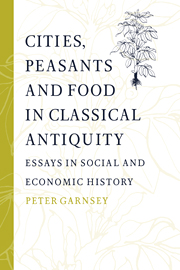Book contents
- Frontmatter
- Contents
- Preface
- Editor's preface
- Acknowledgements
- List of abbreviations
- PART I CITIES
- PART II PEASANTS
- PART III FOOD
- 11 Grain for Athens
- 12 The yield of the land in ancient Greece
- 13 The bean: substance and symbol
- 14 Mass diet and nutrition in the city of Rome
- 15 Child rearing in ancient Italy
- 16 Famine in history
- Bibliography
- Index
15 - Child rearing in ancient Italy
Published online by Cambridge University Press: 02 December 2009
- Frontmatter
- Contents
- Preface
- Editor's preface
- Acknowledgements
- List of abbreviations
- PART I CITIES
- PART II PEASANTS
- PART III FOOD
- 11 Grain for Athens
- 12 The yield of the land in ancient Greece
- 13 The bean: substance and symbol
- 14 Mass diet and nutrition in the city of Rome
- 15 Child rearing in ancient Italy
- 16 Famine in history
- Bibliography
- Index
Summary
The history of childhood in European history takes off in the early modern period, around the sixteenth century. Historians of classical antiquity and the Middle Ages have until recently shown little interest in the topic, largely because their preoccupations have traditionally been different. Shortage of evidence is not an adequate reason or excuse for this neglect. The reconstruction of infant life in early modern Europe is admittedly also a hazardous business. Indeed, Peter Laslett opted to study household size and composition because of the lack of data on infancy. His forthright criticism includes both primary sources (such as personal diaries) and secondary sources (such as advice literature): ‘It is well known how intractable the analysis of any body of documents of this kind can be; so untidy is it, so variable, so contradictory in its dogmas and doctrines, so capricious in what it preserves and what it must leave out’ (Laslett (1977) 66). Linda Pollock is perhaps more representative of early modern social historians in her willingness to work with the sources, while admitting their deficiencies: ‘We still know little about how parents actually reared their children’ (Pollock (1983) 203, 212, 234).
For antiquity, scattered literary discussions and references, though different from the early modern diaries, serve a similarly limited purpose. Between the literary texts, and such diverse sources as papyri recording wet-nurse contracts in Egypt, stone epitaphs for dead infants, and skeletal remains, we do not lack II information (of variable quality and quantity, to be sure) on parent-child attitudes, birth rituals, the treatment of babies, feeding patterns, and the nutritional status of infants.
- Type
- Chapter
- Information
- Cities, Peasants and Food in Classical AntiquityEssays in Social and Economic History, pp. 253 - 271Publisher: Cambridge University PressPrint publication year: 1998
- 3
- Cited by



